The City of Areguá
Neatly nestled between the outer city suburbs of sprawling Asunción, the rolling forested hills of one of the national parks of Paraguay such as the Ypacarai National Park in the north and the vast water expanses of the Ypacarai Lake itself in the east, the city of Areguá is a place at once accessible and alluring. This has made it a favourite getaway for travellers who find themselves exhausted with the metropolitan mechanisation of Paraguay’s capital, while also a great jump off spot for adventure-seekers and intrepid types looking for a gateway into the southern heartlands of the country, outside of the built up areas on the Argentine border.
Most first-time visitors are instantly shocked by the relative ruralism and natural surroundings of a city so close to the capital, where the absence of high rise sky scrapers and big-business buildings helps to retain something of a bucolic character. Ahead of the skyline, guests can spy out the hilly backcountry of Paraguay extending out into the distance, while the shoreline waters of the great Ypacarai Lake are an ever-present reminder of the town’s remoter location.

Quieter and calmer than its metropolitan brother in the west, Areguá is also largely famed for its agricultural output. Of these, it is without question the strawberry that is the most important, and every year, in mid-August, the town comes alive with sellers and famers touting their home-picked goods. This is when Areguá is busiest, but also when it’s at its best, and guests at this time are treated to a truly intriguing image of an agricultural Paraguayan town in bloom, where potters and strawberry pickers enjoy the festivities alongside travellers and town visitors alike.
Other guests come to explore the curious arts and crafts tradition of Areguá, which has long been its second largest source of income. Its history is exhibited in the Centro Artesanal de la Cuenca, where the past of pot making and clay basing is chronicled, and lines and lines of local sellers converge to tour their goods. If you do decide to head here, be sure to take a camera, because the winding streets of clay pot-filled market stalls will definitely warrant a snap or two.
Generally speaking, the whole city is walking-friendly, and guests rarely require the services of a taxi or bus. Consider heading to the lakeside promenade, where the so-called Avenida del Lago offers visitors a montage of waterside views and interesting cultural hotspots. From here it’s possible to spy out the famous church on the hill, a long-time icon on the Areguá skyline and the point which marks the start of the heritage trail through town.
In the centre, Areguá still bears all the hallmarks of the post-colonial, high-society town it once was. For centuries it attracted high rollers from the capital, who came in droves during the height of the Paraguayan summer to cool off in Ypacarai’s waters and sun themselves on the porches of their European-style villas. Many of the latter still exist today in Areguá, peppering the downtown squares and old colonial roadways, adding a dash of Spanish charm to the town.

Another major must see sight can be found just outside of Areguá’s centre, at the spot where the Cerro Koi cliff faces protrude from the ground. They jut out dramatically and soar above the city, displaying one of the most curious rock formations in South America, not to mention one of the rarest on the planet. It’s formed from a patchwork of cuboid-shaped faces that cluster over one another to make a chiselled cliff of dramatic proportions; definitely worth the visit. As with most sites in Areguá, visitors can walk to the spot, while it’s sometimes unfortunately necessary to pass through some of the city’s rougher neighbourhoods, so taking a guide or big group is largely recommended.
At just under an hour’s drive from the centre of Asunción itself, most people choose to arrive in Areguá by car on the major highway of Route Two. There are also regular bus services from the main station in the capital, but this may require passengers to change at the inner-city retail centre of Shopping del Sol, which sits on the north-eastern outskirts of Asunción, at around a third of distance to Areguá itself. For visitors on organised tours around the Ypacarai Lake region, the city is usually incorporated into the itinerary, along with a number of other waterside towns, like Ypacarai itself and Itagua.

